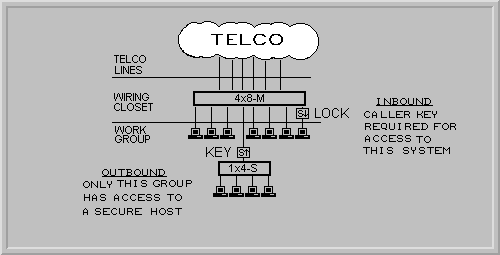TSS NEWS
More TSS Variety
Three new AC powered models have been added to the TSS
(Telephone Line Sharing Switch) family; the 1x4-M, the 1x8-M and the 2x4-M. The
1x4-M and 1x8-M allow one telephone line to be shared among four or eight users,
respectively, and the 2x4-M allows two telephone lines to shared among four users
In the event that you are not familiar with the TSS family of line sharing
switches, they are primarily used for outbound access to allow a number
of modems to share a lesser number of telephone lines. They also address inbound
calls, but not in a shared mode.
Using the TSS, any modem or fax or voice set for that matter, can bid for any
available line. Line utilization really increases when it's shared between
multiple callers. It's great for shared Internet access. Although this is not
an "IP address sharing unit", it can be used with them to provide access to
lines that may be available.
Various models are available that can handle from 1-6 telephone lines with up to
64 outbound modem ports (see TSS Expansion Modules). Inbound calls are
designated to specific ports, depending on the model.
TSS Customer Comments
"I was able to get rid of 8 of my 12 TelCo lines without any additional wait
time. It's amazing how the shared line availability increases exponentially as
lines are added."
"The TSSs fit our real estate application like a glove. The agents are out most
of the time, but when they come in, they need the lines."
"Our 200 store installation was completed without a hitch. The TSSs and
Challengers provided a straight forward installation."
Call Waiting Switches
The Call Waiting Switches are another method of sharing a
phone line. They allow you to use a single phone line for Internet access (modem)
while not missing any inbound calls thereby sharing the line between the two functions.
Newer modems try to error correct the call waiting tone making it invisible to
the user.
The Call Waiting products connect to the phone line like an answering machine
and filter the call waiting tone from the overlapping modem signals. They alert
the user, through a beeping sound and a flashing LED that a call is waiting.
The user may accept the call or ignore it. A larger software controlled model
can also recognize Caller ID. It provides a "screen pop" to the identity of the
caller. The three call waiting products can be further reviewed at
http://www.cpscom.com/cwp.htm.
Combining the Products
Each of these products provides an economic advantage in increasing the
efficiency and reducing the cost of telephone lines. However, by combining the
products this advantage can be increased exponentially. To see how, review the
article "Optimizing SOHO Telephone Lines With
Call Waiting". It describes how all of your phone lines can be used for
Internet access without ever missing an inbound call.
The ATTACHED CHART summarizes the TSS family of
products, Call Waiting Switches, as well as others.
Inbound "Sharing" Switches
The Inbound Switches allow the callers to select the port to which they wish to
connect.
They are normally used for remote maintenance applications, to select various
servers or to selectively control AC power remotely.
They also function as outbound Sharing Switches when outbound calls are placed.
If you would like further information on any of the products, please call:
1-800-888-0051 or visit our web site.
Use Challenger Dial Security Products With The TSS
 Now that the TSS (TelCo Sharing Switch) is becoming a recognized alternate to
modem servers on LANs and they are being implemented in remote maintenance
configurations, some attention is shifting toward dial security; especially by
those that are dialing their mainframe or corporate servers.
Now that the TSS (TelCo Sharing Switch) is becoming a recognized alternate to
modem servers on LANs and they are being implemented in remote maintenance
configurations, some attention is shifting toward dial security; especially by
those that are dialing their mainframe or corporate servers.
Simply by placing one Challenger Security Key (
CPS's family of Dial Security Products) on each
line or at specific work groups, any of the systems in that group can access a
corporate system that is secured with corresponding Challenger Lock. Other
outbound calls to non-secure sites, such as to the Internet, pass through transparently.
See diagram.
Inbound calls can be handled in a similar manner. By placing a Challenger Lock
on a server or a work group line, only authorized calls with a Security key
connected to the callers modem will be able to access the secured server. This
is great for remote maintenance applications on shared telephone lines. The
server or other monitoring equipment may also place outbound "alarm calls".
This can be a very flexible system depending on where and which type of
Challenger Locks and Keys are used.
The Inbound Sharing Switches already have various built in security
measures so the Lock may not be necessary, only the Keys on the
callers modem. Some also recognized touch-tone passwords and Caller ID.
Click here to review the Challenger Dial Security Concept
and products.
| 